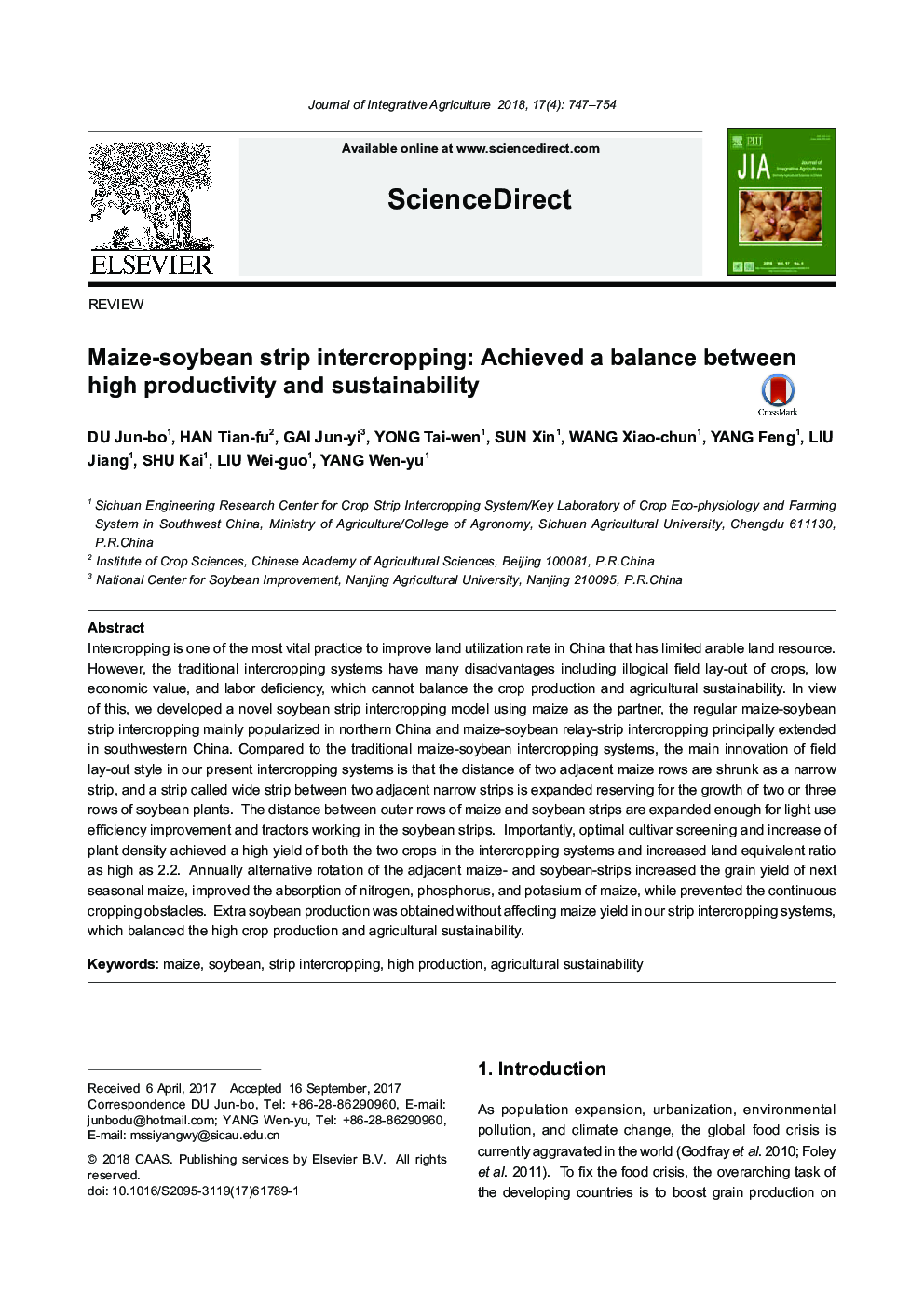| کد مقاله | کد نشریه | سال انتشار | مقاله انگلیسی | نسخه تمام متن |
|---|---|---|---|---|
| 8875626 | 1623698 | 2018 | 8 صفحه PDF | دانلود رایگان |
عنوان انگلیسی مقاله ISI
Maize-soybean strip intercropping: Achieved a balance between high productivity and sustainability
ترجمه فارسی عنوان
کشت مخلوط نوار ذرت و سویا: تعادل بین بهره وری بالا و پایداری را به دست
دانلود مقاله + سفارش ترجمه
دانلود مقاله ISI انگلیسی
رایگان برای ایرانیان
کلمات کلیدی
ذرت، سویا، نوار مخلوط کردن، تولید بالا، پایداری کشاورزی،
ترجمه چکیده
کشت مخلوط یکی از حیاتی ترین اقدامات برای بهبود میزان بهره برداری زمین در چین است که منابع زمین های زراعی محدودی دارد. با این حال، سیستم های کشت مخلوط سنتی دارای معایب بسیاری هستند از جمله عدم انعطاف پذیری محصول، ارزش اقتصادی پایین و کمبود کار، که نمی تواند تولید محصول و پایداری کشاورزی را متعادل سازد. با توجه به این، ما یک مدل ترکیبی جدید از سویا را با استفاده از ذرت به عنوان همکار، کشت مخلوط نوار غلات ذرت و سویا به طور عمده در شمال چین و میان مخلوط بذرهای بذر ذرت و سویا عمدتا در جنوب غربی چین گسترش یافته است. در مقایسه با سیستم های مخلوط سنتی ذرت و سویا، نوآوری اصلی طرح ریزی زمینه در سیستم های همکاری فعلی ما این است که فاصله دو ردیف ذرت مجاور به عنوان یک نوار باریک کاهش یافته است و یک نوار به نام نوار وسیع بین دو مجاورت مجاورت نوار ها برای حفظ رشد دو یا سه ردیف گیاه سویا گسترش می یابد. فاصله بین سطوح بیرونی ذرت و نوارهای سویا به اندازه کافی برای بهبود بهره وری سوخت و تراکتور در نوار های سویا به اندازه کافی گسترش می یابد. مهمتر از همه، غربالگری رقم مطلوب و افزایش تراکم بوته، عملکرد بالا در هر دو محصول در سیستم های کشت مخلوط و افزایش نسبت معادل زمین به عنوان 2.2 بود. چرخش متناوب سالانه بذرهای مجاور و سویا سبب افزایش عملکرد دانه ذرت فصلی شده، جذب نیتروژن، فسفر و پتاسیم ذرت را بهبود می بخشد، در حالی که از موانع کشت مداوم جلوگیری می کند. تولید سویا بی اثر بدون تاثیر بر عملکرد ذرت در سیستم های کشت مخلوط ما، که تولید محصول بالا و پایداری کشاورزی را متعادل می کند.
موضوعات مرتبط
علوم زیستی و بیوفناوری
علوم کشاورزی و بیولوژیک
علوم کشاورزی و بیولوژیک (عمومی)
چکیده انگلیسی
Intercropping is one of the most vital practice to improve land utilization rate in China that has limited arable land resource. However, the traditional intercropping systems have many disadvantages including illogical field lay-out of crops, low economic value, and labor deficiency, which cannot balance the crop production and agricultural sustainability. In view of this, we developed a novel soybean strip intercropping model using maize as the partner, the regular maize-soybean strip intercropping mainly popularized in northern China and maize-soybean relay-strip intercropping principally extended in southwestern China. Compared to the traditional maize-soybean intercropping systems, the main innovation of field lay-out style in our present intercropping systems is that the distance of two adjacent maize rows are shrunk as a narrow strip, and a strip called wide strip between two adjacent narrow strips is expanded reserving for the growth of two or three rows of soybean plants. The distance between outer rows of maize and soybean strips are expanded enough for light use efficiency improvement and tractors working in the soybean strips. Importantly, optimal cultivar screening and increase of plant density achieved a high yield of both the two crops in the intercropping systems and increased land equivalent ratio as high as 2.2. Annually alternative rotation of the adjacent maize- and soybean-strips increased the grain yield of next seasonal maize, improved the absorption of nitrogen, phosphorus, and potasium of maize, while prevented the continuous cropping obstacles. Extra soybean production was obtained without affecting maize yield in our strip intercropping systems, which balanced the high crop production and agricultural sustainability.
ناشر
Database: Elsevier - ScienceDirect (ساینس دایرکت)
Journal: Journal of Integrative Agriculture - Volume 17, Issue 4, April 2018, Pages 747-754
Journal: Journal of Integrative Agriculture - Volume 17, Issue 4, April 2018, Pages 747-754
نویسندگان
Jun-bo DU, Tian-fu HAN, Jun-yi GAI, Tai-wen YONG, Xin SUN, Xiao-chun WANG, Feng YANG, Jiang LIU, Kai SHU, Wei-guo LIU, Wen-yu YANG,
